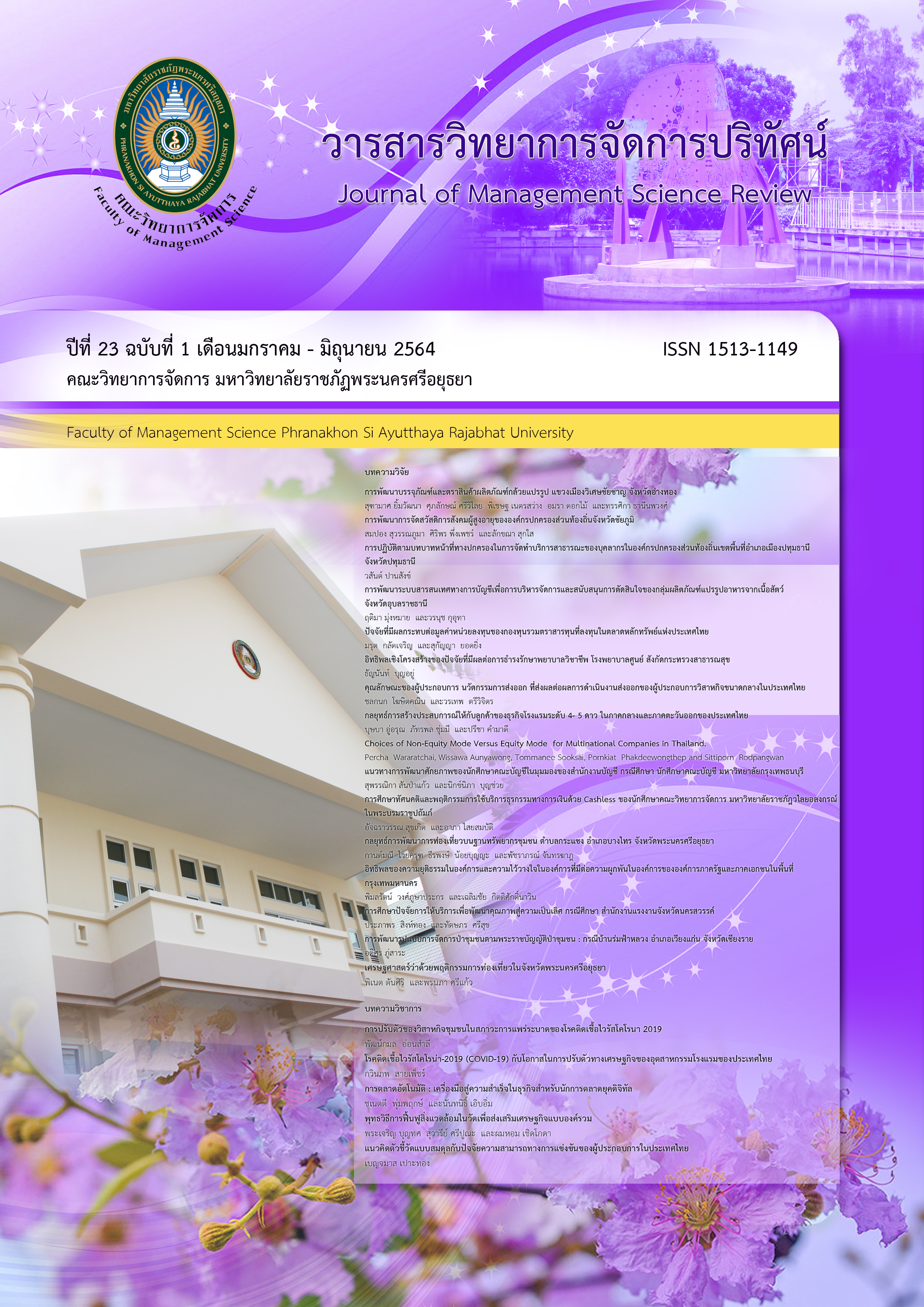Choices of Non-Equity Mode Versus Equity Mode for Multinational Companies
คำสำคัญ:
Foreign Market Entry Modes, Cultural Dimensions, Resource-Based View, Special Economic Zoneบทคัดย่อ
This research aims to understand the decision making of foreign entrepreneurs in choosing modes of foreign market entry in relation to the differences in cultural characteristics of the entrepreneurs, locations of the businesses, and the business experiences. The hypotheses were based on the differences in cultural characteristics of these entrepreneurs, locations of the businesses, and the business experiences affecting differences in decision making of foreign entrepreneurs in choosing modes of foreign market entry divided into Equity modes versus Non-Equity Modes. Convenience sampling was used for distribution the 100 questionnaires to international businesses in various industries, divided into 50 businesses located in Special Economic Zone or Costal areas and 50 businesses located outside Special Economic Zone or Costal area. The data was analyzed using multiple regressions.
The study found that the more entrepreneur value high power distance leads to the high tendency to use equity modes of foreign market entry. Moreover, it also found that the more entrepreneur value low uncertainty avoidance, compared with those who value high uncertainty avoidance, leads to the high tendency to use equity modes of foreign market entry. However, high business experiences and doing business in special economic zone or costal area are not the factors affecting entrepreneurs’ decision to choose either non-entry modes or entry modes of foreign market entry. As a result, these findings support past research on the relationship between cultural dimensions and foreign market entry modes.
เอกสารอ้างอิง
Barney, J. (1991). Firm resources and sustained competitive advantage. Journal of Management, 17(1), 99-120.
Board of Investment of Thailand. (2016). Investment in special economic development zones. Retrieved May 25, 2016, from http://www.boi.go.th/upload/content/BOI-book%202015_20150818_95385.pdf
Buckley, P.J. and Casson, M. (1998). Analyzing foreign market entry strategies: extending the internalization approach. Journal of International Business Studies, 29(3), 539-561.
Bundit Phrapratanporn, Preecha Wararatchai, Wissawa Aunyawong, and Nik Ramli Nik Abdul Rashid. (2019). Enhancing supply chain performance of SMEs in Thailand using the integrated personnel development model. International Journal of Supply Chain Management, 8(5), 176-186.
Chu, W. and Anderson, E. M. (1992). Capturing ordinal properties of categorical dependentvariables: A review with application to modes of foreign entry. International Journal of Research in Marketing. 9(2), 149-160.
Department of Local Administration. (2016). Problems or Obstacles of Special Economic Zone in the present day. Retrieved May 20, 2016, from http://www.wiangphangkham.go.th/images/column_1431354069/218.pdf
Dunning, J. H. (1979). Toward an eclectic theory of international production: some empirical tests. Journal of International Business Studies, 11(1), 9–31.
Dunning, John H. 2004. The eclectic paradigm as an envelope for economic and business theories of MNE activity. Journal of International Business Review, 9(2), 163-190.
Ganesh, J., Kumar, V. and Subramaniam, V. (1997. Learning effect in multinational diffusion of consumer durables: An exploratory investigation. Journal of the Academy of Marketing Science Summer, 25(3), 214-228.
Goodrick, E. and Salancik, G. R. (1996). Organizational discretion in responding toinstitutional practices: hospitals and cesarean births. Administrative Science Quarterly, 41(1), 1-28.
Gray, H. P. (2003). Extending the eclectic paradigm in international business: essays in honor of john dunning. Massachusetts: Edward Elga.
Hennart, J. (2009). Down with MNE-centric theories! Market entry and expansion as the bundling of MNE and local assets. Journal of International Business Studies, 40(9), 1432-1454.
Hoefstede, G. (1994). Management scientists are human. Management Science, 40(1), 4-13.
Madhok, A. (1997). Cost, Value and foreign market entry modes: The transaction and the firm. Strategic Management Journal, 18, 39-16.
Mahoney, J. T. and Pandian, J. R. (1992). The resource-based view within the conversation of strategic management. Strategic Management Journal, 13(5), 363-380.
Makino, S. and Neupert, K.E. (2000). National Culture, Transaction Costs, and the Choice betweenJointVenture and Wholly Owned Subsidiary. Journal of International Business Studies, 31(4), 705-713.
Peteraf, M. A. (1995). The cornerstones of competitive advantage: A resource-based view. Strategic Management Journal, 14(3), 179-191.
Schneider, S. C. and De Meyer, A. (1991). Interpreting and responding to strategic issues: The impact of national culture. Strategic Management Journal, 12(4), 307-320.
Pimploi Tirastittam and Phuttiwat Waiyawuththanapoom. (2014). Public transport planning system by dijkstra algorithm: case study bangkok metropolitan area. International Journal of Social, Behavioral, Educational, Economic, Business and Industrial Engineering, 8(1), 54-59.
Tse, D. K., Pan, Y. and Au, Kevin Y. (1997). How MNCs choose entry modes and form alliances: The China experience. Journal of International Business Studies, 28(4), 779–805.
Twomey, M. J. (2000). A Century of foreign investment in the third world. New York: Routledge.
Wennekers, S., Thurik, R., Stel, A. van and Noorderhaven, N. (2007). Uncertainty avoidance and the rate of business ownership across 21 OECD countries, 1976–2004. Journal of Evolutionary Economics, 17(2), 133-160.
Yoo, B., Donthu, N. and Lenartowicz, T. (2011). Measuring Hofstede's five dimensions of cultural values at the individual level: development and validation of CVSCALE. Journal of International Consumer Marketing, 23(3), 193-210.





